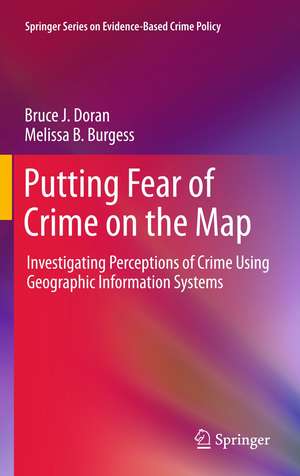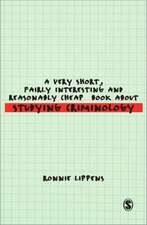Putting Fear of Crime on the Map: Investigating Perceptions of Crime Using Geographic Information Systems: Springer Series on Evidence-Based Crime Policy
Autor Bruce J. Doran, Melissa B. Burgessen Limba Engleză Paperback – 24 oct 2013
The first part of the book outlines the history of research into fear of crime, with an emphasis on the many approaches that have been used to investigate the problem and the need for a spatially-explicit approach. The second part provides a technical break down of the GIS-based techniques used to map fear of crime and summarises key findings from two separate study sites. The authors describe collective avoidance behaviour in relation to disorder decline models such as the Broken Windows Thesis, the potential to integrate fear mapping with police-community partnerships and emerging avenues for further research. Issues discussed include fear of crime in relation to housing prices and disorder, the use of fear mapping as a means with which to monitor the impact of Closed Circuit Television (CCTV) and fear mapping in transit environments.
| Toate formatele și edițiile | Preț | Express |
|---|---|---|
| Paperback (1) | 640.71 lei 6-8 săpt. | |
| Springer – 24 oct 2013 | 640.71 lei 6-8 săpt. | |
| Hardback (1) | 645.47 lei 6-8 săpt. | |
| Springer – 20 sep 2011 | 645.47 lei 6-8 săpt. |
Preț: 640.71 lei
Preț vechi: 753.77 lei
-15% Nou
Puncte Express: 961
Preț estimativ în valută:
122.61€ • 125.57$ • 101.100£
122.61€ • 125.57$ • 101.100£
Carte tipărită la comandă
Livrare economică 18 martie-01 aprilie
Preluare comenzi: 021 569.72.76
Specificații
ISBN-13: 9781461429852
ISBN-10: 1461429854
Pagini: 304
Ilustrații: XVIII, 286 p.
Dimensiuni: 155 x 235 x 16 mm
Greutate: 0.43 kg
Ediția:2012
Editura: Springer
Colecția Springer
Seria Springer Series on Evidence-Based Crime Policy
Locul publicării:New York, NY, United States
ISBN-10: 1461429854
Pagini: 304
Ilustrații: XVIII, 286 p.
Dimensiuni: 155 x 235 x 16 mm
Greutate: 0.43 kg
Ediția:2012
Editura: Springer
Colecția Springer
Seria Springer Series on Evidence-Based Crime Policy
Locul publicării:New York, NY, United States
Public țintă
ResearchCuprins
Chapter 1: Introduction.- Chapter 2: Why is fear of crime a serious social problem?.- Chapter 3: What causes fear of crime?.-Chapter 4: Managing fear of crime.- Chapter 5: Investigating the fear of crime.- Chapter 6: The Wollongong Study.- Chapter 7: The Kings Cross Study.- Chapter 8: Future avenues for fear mapping: potential applications and improvements.
Notă biografică
Dr Bruce Doran is a lecturer at the Fenner School of Environment and Society, Australian National University. His research interests relate to the applied use of GIS-based techniques to investigate urban and biophysical problems, with a particular focus on strategic management and Decision Support Systems (DSS). Over recent years he has been developing techniques to investigate spatio-temporal links between the fear of crime and the actual occurrence of crime.
Dr Melissa Burgess completed a PhD looking into spatio-temporal patterns of avoidance in Kings Cross, Sydney. She has worked as a spatial analyst with the NSW Bureau of Crime Statistics and Research and is currently working for the United Nations Development Program (UNDP) in Bangkok, Thailand.
Dr Melissa Burgess completed a PhD looking into spatio-temporal patterns of avoidance in Kings Cross, Sydney. She has worked as a spatial analyst with the NSW Bureau of Crime Statistics and Research and is currently working for the United Nations Development Program (UNDP) in Bangkok, Thailand.
Textul de pe ultima copertă
The impact of crime on society is well-known and well-documented. But fear of crime also takes a major toll, affecting individual mobility, neighborhood cohesion, and local economies, and is an increasingly important topic in criminology and other disciplines. In recent years, Geographic Information Systems technology has brought needed spatial dimensions to research into fear of crime.
Putting Fear of Crime on the Map reviews these efforts, chronicling the evolution of both research and technology. Fear of crime is defined as a complex system of avoidance behaviors that paradoxically helps create conditions favorable to crime, and the authors summarize approaches used in understanding the problem. In later chapters, data from two landmark studies examine new ways of conceptualizing and addressing fear of crime offered by GIS technology, and the authors present innovative GIS-based methods for reducing fear of crime, as well as in monitoring the effectiveness of law enforcement and community initiatives.
Key features of the book:
· Historical and current trends in fear of crime research.
· Analysis of fear of crime is a serious analytical and social problem.
· Social/environmental theories explaining fear of crime.
· Technical breakdown of Geographic Information Systems techniques used to map fear of crime.
· Findings from eight years of studies of fear of crime using GIS technology.
· Potential applications for fear mapping, and emerging areas for fear of crime research.
Putting Fear of Crime on the Map is a unique source of information for graduate and postgraduateresearchers in criminology, and policy makers.
Putting Fear of Crime on the Map reviews these efforts, chronicling the evolution of both research and technology. Fear of crime is defined as a complex system of avoidance behaviors that paradoxically helps create conditions favorable to crime, and the authors summarize approaches used in understanding the problem. In later chapters, data from two landmark studies examine new ways of conceptualizing and addressing fear of crime offered by GIS technology, and the authors present innovative GIS-based methods for reducing fear of crime, as well as in monitoring the effectiveness of law enforcement and community initiatives.
Key features of the book:
· Historical and current trends in fear of crime research.
· Analysis of fear of crime is a serious analytical and social problem.
· Social/environmental theories explaining fear of crime.
· Technical breakdown of Geographic Information Systems techniques used to map fear of crime.
· Findings from eight years of studies of fear of crime using GIS technology.
· Potential applications for fear mapping, and emerging areas for fear of crime research.
Putting Fear of Crime on the Map is a unique source of information for graduate and postgraduateresearchers in criminology, and policy makers.
Caracteristici
New application of GIS technology to understand people's perceived crime risk Provides new theoretical framework for crime management down to the individual community level Delivers detailed case studies, with broad theoretical and policy applications Includes supplementary material: sn.pub/extras















